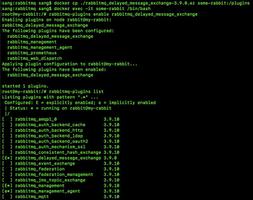Python操作rabbitMQ的示例代码
引入
RabbitMQ 是一个由 Erlang 语言开发的 AMQP 的开源实现。
rabbitMQ是一款基于AMQP协议的消息中间件,它能够在应用之间提供可靠的消息传输。在易用性,扩展性,高可用性上表现优秀。使用消息中间件利于应用之间的解耦,生产者(客户端)无需知道消费者(服务端)的存在。而且两端可以使用不同的语言编写,大大提供了灵活性。
中文文档
安装
# 安装配置epel源
rpm -ivh http://dl.fedoraproject.org/pub/epel/6/i386/epel-release-6-8.noarch.rpm
# 安装erlang
yum -y install erlang
# 安装RabbitMQ
yum -y install rabbitmq-server
# 启动/停止
service rabbitmq-server start/stop
rabbitMQ工作模型
简单模式
生产者
import pika
connection = pika.BlockingConnection(pika.ConnectionParameters( host='localhost'))
channel = connection.channel()
channel.queue_declare(queue='hello')
channel.basic_publish(exchange='',
routing_key='hello',
body='Hello World!')
print(" [x] Sent 'Hello World!'")
connection.close()
消费者
connection = pika.BlockingConnection(pika.ConnectionParameters(host='localhost'))
channel = connection.channel()
channel.queue_declare(queue='hello')
def callback(ch, method, properties, body):
print(" [x] Received %r" % body)
channel.basic_consume( callback,
queue='hello',
no_ack=True)
print(' [*] Waiting for messages. To exit press CTRL+C')
channel.start_consuming()
相关参数
1,no-ack = False
如果消费者遇到情况(its channel is closed, connection is closed, or TCP connection is lost)挂掉了,那么,RabbitMQ会重新将该任务添加到队列中。
- 回调函数中的 ch.basic_ack(delivery_tag=method.delivery_tag)
- basic_comsume中的no_ack=False
接收消息端应该这么写:
Q
import pika
connection = pika.BlockingConnection(pika.ConnectionParameters(
host='10.211.55.4'))
channel = connection.channel()
channel.queue_declare(queue='hello')
def callback(ch, method, properties, body):
print(" [x] Received %r" % body)
import time
time.sleep(10)
print 'ok'
ch.basic_ack(delivery_tag = method.delivery_tag)
channel.basic_consume(callback,
queue='hello',
no_ack=False)
print(' [*] Waiting for messages. To exit press CTRL+C')
channel.start_consuming()
2,durable :消息不丢失
生产者
import pika
connection = pika.BlockingConnection(pika.ConnectionParameters(host='10.211.55.4'))
channel = connection.channel()
# make message persistent
channel.queue_declare(queue='hello', durable=True)
channel.basic_publish(exchange='',
routing_key='hello',
body='Hello World!',
properties=pika.BasicProperties(
delivery_mode=2, # make message persistent
))
print(" [x] Sent 'Hello World!'")
connection.close()
3,消息获取顺序
默认消息队列里的数据是按照顺序被消费者拿走,例如:消费者1 去队列中获取 奇数 序列的任务,消费者1去队列中获取 偶数 序列的任务。
channel.basic_qos(prefetch_count=1) 表示谁来谁取,不再按照奇偶数排列
import pika
connection = pika.BlockingConnection(pika.ConnectionParameters(host='10.211.55.4'))
channel = connection.channel()
# make message persistent
channel.queue_declare(queue='hello')
def callback(ch, method, properties, body):
print(" [x] Received %r" % body)
import time
time.sleep(10)
print 'ok'
ch.basic_ack(delivery_tag = method.delivery_tag)
channel.basic_qos(prefetch_count=1)
channel.basic_consume(callback,
queue='hello',
no_ack=False)
print(' [*] Waiting for messages. To exit press CTRL+C')
channel.start_consuming()
exchange模型
1,发布订阅
发布订阅和简单的消息队列区别在于,发布订阅会将消息发送给所有的订阅者,而消息队列中的数据被消费一次便消失。所以,RabbitMQ实现发布和订阅时,会为每一个订阅者创建一个队列,而发布者发布消息时,会将消息放置在所有相关队列中。
exchange type = fanout
生产者
import pika
import sys
connection = pika.BlockingConnection(pika.ConnectionParameters(
host='localhost'))
channel = connection.channel()
channel.exchange_declare(exchange='logs',
type='fanout')
message = ' '.join(sys.argv[1:]) or "info: Hello World!"
channel.basic_publish(exchange='logs',
routing_key='',
body=message)
print(" [x] Sent %r" % message)
connection.close()
消费者
import pika
connection = pika.BlockingConnection(pika.ConnectionParameters(
host='localhost'))
channel = connection.channel()
channel.exchange_declare(exchange='logs',
type='fanout')
result = channel.queue_declare(exclusive=True)
queue_name = result.method.queue
channel.queue_bind(exchange='logs',
queue=queue_name)
print(' [*] Waiting for logs. To exit press CTRL+C')
def callback(ch, method, properties, body):
print(" [x] %r" % body)
channel.basic_consume(callback,
queue=queue_name,
no_ack=True)
channel.start_consuming()
2,关键字发送
之前事例,发送消息时明确指定某个队列并向其中发送消息,RabbitMQ还支持根据关键字发送,即:队列绑定关键字,发送者将数据根据关键字发送到消息exchange,exchange根据 关键字 判定应该将数据发送至指定队列。
exchange type = direct
import pika
import sys
connection = pika.BlockingConnection(pika.ConnectionParameters(
host='localhost'))
channel = connection.channel()
channel.exchange_declare(exchange='direct_logs',
type='direct')
result = channel.queue_declare(exclusive=True)
queue_name = result.method.queue
severities = sys.argv[1:]
if not severities:
sys.stderr.write("Usage: %s [info] [warning] [error]\n" % sys.argv[0])
sys.exit(1)
for severity in severities:
channel.queue_bind(exchange='direct_logs',
queue=queue_name,
routing_key=severity)
print(' [*] Waiting for logs. To exit press CTRL+C')
def callback(ch, method, properties, body):
print(" [x] %r:%r" % (method.routing_key, body))
channel.basic_consume(callback,
queue=queue_name,
no_ack=True)
channel.start_consuming()
3,模糊匹配
exchange type = topic
发送者路由值 队列中
old.boy.python old.* -- 不匹配
old.boy.python old.# -- 匹配
在topic类型下,可以让队列绑定几个模糊的关键字,之后发送者将数据发送到exchange,exchange将传入”路由值“和 ”关键字“进行匹配,匹配成功,则将数据发送到指定队列。
- # 表示可以匹配 0 个 或 多个 单词
- * 表示只能匹配 一个 单词
import pika
import sys
connection = pika.BlockingConnection(pika.ConnectionParameters(
host='localhost'))
channel = connection.channel()
channel.exchange_declare(exchange='topic_logs',
type='topic')
result = channel.queue_declare(exclusive=True)
queue_name = result.method.queue
binding_keys = sys.argv[1:]
if not binding_keys:
sys.stderr.write("Usage: %s [binding_key]...\n" % sys.argv[0])
sys.exit(1)
for binding_key in binding_keys:
channel.queue_bind(exchange='topic_logs',
queue=queue_name,
routing_key=binding_key)
print(' [*] Waiting for logs. To exit press CTRL+C')
def callback(ch, method, properties, body):
print(" [x] %r:%r" % (method.routing_key, body))
channel.basic_consume(callback,
queue=queue_name,
no_ack=True)
channel.start_consuming()
基于rabbitMQ的RPC
Callback queue 回调队列
一个客户端向服务器发送请求,服务器端处理请求后,将其处理结果保存在一个存储体中。而客户端为了获得处理结果,那么客户在向服务器发送请求时,同时发送一个回调队列地址 reply_to 。
Correlation id 关联标识
一个客户端可能会发送多个请求给服务器,当服务器处理完后,客户端无法辨别在回调队列中的响应具体和那个请求时对应的。为了处理这种情况,客户端在发送每个请求时,同时会附带一个独有 correlation_id 属性,这样客户端在回调队列中根据 correlation_id 字段的值就可以分辨此响应属于哪个请求。
客户端发送请求:
某个应用将请求信息交给客户端,然后客户端发送RPC请求,在发送RPC请求到RPC请求队列时,客户端至少发送带有reply_to以及correlation_id两个属性的信息
服务端工作流:
等待接受客户端发来RPC请求,当请求出现的时候,服务器从RPC请求队列中取出请求,然后处理后,将响应发送到reply_to指定的回调队列中
客户端接受处理结果:
客户端等待回调队列中出现响应,当响应出现时,它会根据响应中correlation_id字段的值,将其返回给对应的应用
服务者
import pika
# 建立连接,服务器地址为localhost,可指定ip地址
connection = pika.BlockingConnection(pika.ConnectionParameters(
host='localhost'))
# 建立会话
channel = connection.channel()
# 声明RPC请求队列
channel.queue_declare(queue='rpc_queue')
# 数据处理方法
def fib(n):
if n == 0:
return 0
elif n == 1:
return 1
else:
return fib(n-1) + fib(n-2)
# 对RPC请求队列中的请求进行处理
def on_request(ch, method, props, body):
n = int(body)
print(" [.] fib(%s)" % n)
# 调用数据处理方法
response = fib(n)
# 将处理结果(响应)发送到回调队列
ch.basic_publish(exchange='',
routing_key=props.reply_to,
properties=pika.BasicProperties(correlation_id = \
props.correlation_id),
body=str(response))
ch.basic_ack(delivery_tag = method.delivery_tag)
# 负载均衡,同一时刻发送给该服务器的请求不超过一个
channel.basic_qos(prefetch_count=1)
channel.basic_consume(on_request, queue='rpc_queue')
print(" [x] Awaiting RPC requests")
channel.start_consuming()
客户端
import pika
import uuid
class FibonacciRpcClient(object):
def __init__(self):
"""
客户端启动时,创建回调队列,会开启会话用于发送RPC请求以及接受响应
"""
# 建立连接,指定服务器的ip地址
self.connection = pika.BlockingConnection(pika.ConnectionParameters(
host='localhost'))
# 建立一个会话,每个channel代表一个会话任务
self.channel = self.connection.channel()
# 声明回调队列,再次声明的原因是,服务器和客户端可能先后开启,该声明是幂等的,多次声明,但只生效一次
result = self.channel.queue_declare(exclusive=True)
# 将次队列指定为当前客户端的回调队列
self.callback_queue = result.method.queue
# 客户端订阅回调队列,当回调队列中有响应时,调用`on_response`方法对响应进行处理;
self.channel.basic_consume(self.on_response, no_ack=True,
queue=self.callback_queue)
# 对回调队列中的响应进行处理的函数
def on_response(self, ch, method, props, body):
if self.corr_id == props.correlation_id:
self.response = body
# 发出RPC请求
def call(self, n):
# 初始化 response
self.response = None
#生成correlation_id
self.corr_id = str(uuid.uuid4())
# 发送RPC请求内容到RPC请求队列`rpc_queue`,同时发送的还有`reply_to`和`correlation_id`
self.channel.basic_publish(exchange='',
routing_key='rpc_queue',
properties=pika.BasicProperties(
reply_to = self.callback_queue,
correlation_id = self.corr_id,
),
body=str(n))
while self.response is None:
self.connection.process_data_events()
return int(self.response)
# 建立客户端
fibonacci_rpc = FibonacciRpcClient()
# 发送RPC请求
print(" [x] Requesting fib(30)")
response = fibonacci_rpc.call(30)
print(" [.] Got %r" % response)
以上是 Python操作rabbitMQ的示例代码 的全部内容, 来源链接: utcz.com/z/312743.html







